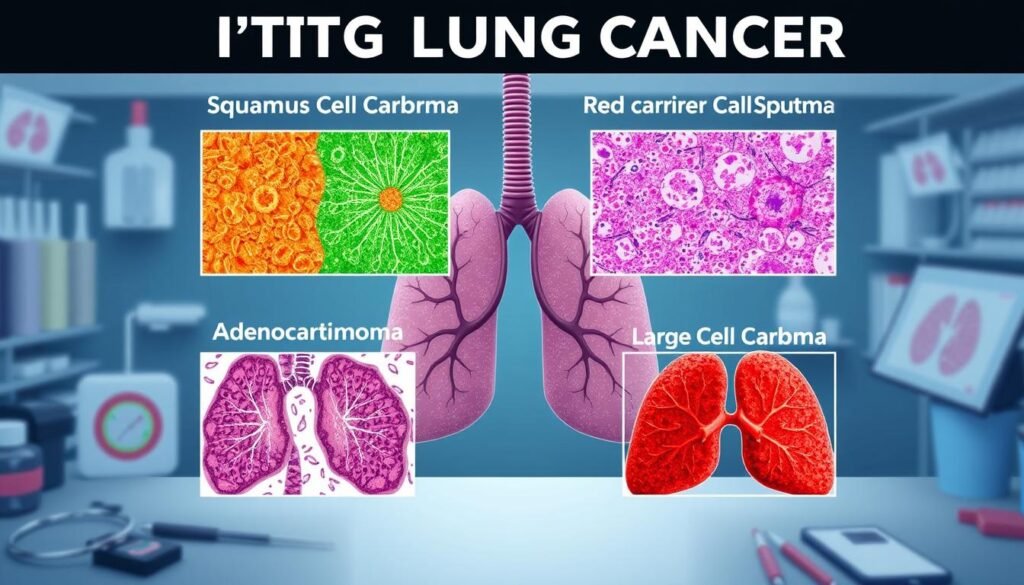About 65% of people with lung cancer have a lasting cough. This shows how a cough is linked to the disease. Understanding sputum in lung cancer is key. Often, signs go unnoticed until the condition worsens. Early detection is therefore very important.
Changes in sputum can signal big changes in the lungs. It’s crucial not to ignore them. This article will explore what sputum is, lung cancer signs in sputum, and why seeing a doctor for unusual symptoms is important.
Key Takeaways
- Lung cancer sputum can highlight serious health issues, particularly with a persistent cough.
- Changes in sputum color or consistency can be indicators of lung cancer symptoms.
- Recognizing signs early may aid in the effective intervention of lung cancer.
- Consulting a healthcare professional upon noticing unusual sputum changes is essential.
- Regular awareness of symptoms can lead to earlier diagnoses and potential treatment options.
Introduction to Lung Cancer Symptoms
Lung cancer leads in causing deaths among all genders. It presents symptoms that are often unclear, making early detection hard. Signs like a lasting cough that gets worse are common. Weight loss without trying can also be a clue, especially if it’s ignored.
Lung cancer symptoms might not show until it’s quite advanced. This includes chest pain or having a hard time breathing. These signs should be taken seriously. Even if they seem like they could be something else, like COPD or an infection, seeing a doctor right away is key. Quick diagnosis and the right treatment can make a big difference.
What is Sputum?
Sputum is a thick fluid made by our respiratory system. It’s made of saliva, mucus, dead cells, and germs. Knowing about sputum helps doctors find lung problems, including lung cancer risks.
Definition and Importance of Sputum
This thick fluid is key for keeping our lungs safe. It catches dust, germs, and other particles. This stops them from getting into our lungs. Sputum production is our body’s way of cleaning out these harmful things.
Changes in the sputum’s look or amount can warn us of health issues. For example, dark yellow or green sputum may mean a bacterial infection like pneumonia. Pink sputum could be a sign of pulmonary edema.
How Sputum is Produced in the Lungs
Special cells in our airways make sputum when there’s irritation or infection. People with asthma or COPD often make more sputum.
A sputum culture can find specific germs. This helps diagnose and treat diseases like pneumonia or TB. Quick sputum tests help doctors decide the best treatment.

Understanding sputum helps diagnose lung diseases better. For more info on how sputum changes show health problems, visit here.
Recognizing Lung Cancer Sputum Signs
Knowing the signs of lung cancer in sputum is key for early diagnosis. One might notice changes in sputum, signaling health issues. Look for changes in color, thickness, or blood.
Common Characteristics of Lung Cancer Sputum
Lung cancer sputum has unique features to be aware of. It might become thicker and change color. Here are the most worrying signs:
- Increased viscosity of sputum, making it thicker than usual.
- Presence of blood that may appear as bright red or rust-colored mucus.
- Discoloration, particularly rust-colored sputum, which signals severe health problems.
These signs should lead to immediate medical attention. They could suggest tumors in the airways or lung bleeds.
Coughing Up Blood or Rust-Colored Sputum
Coughing up blood or seeing rust-colored mucus is a severe sign of lung cancer. If this happens, see a doctor right away. These signs could mean damaged blood vessels in the lungs or other serious conditions.
Monitoring changes in your sputum is critical. Especially if you’re coughing up blood or rust-colored mucus. Being aware and seeking help early improves chances for successful treatment of lung cancer symptoms.
Types of Lung Cancer and Their Associated Sputum Signs
Lung cancer comes in two main types: non-small cell (NSCLC) and small cell (SCLC). NSCLC makes up 80% to 85% of all lung cancer cases. It has subtypes like adenocarcinoma, squamous cell carcinoma, and large cell carcinoma. Each subtype leads to different sputum symptoms, which are key for diagnosis.
Adenocarcinoma, the most common NSCLC, typically shows minor sputum changes. It occurs more often in women than in men. Squamous cell carcinoma, linked to smoking, shows changes more noticeable in the lung’s central areas.
SCLC, which is 10% to 15% of lung cancer cases, grows quickly and spreads fast. People with SCLC see sudden and significant sputum changes. This type is often diagnosed at a late stage, making sputum tests critical for understanding the disease’s path.
Knowing the differences in lung cancer types and their sputum signs helps doctors create better treatment plans. Below is a side-by-side comparison of the two main categories:
| Type of Lung Cancer | Percentage of Cases | Sputum Characteristics | Common Patient Demographics |
|---|---|---|---|
| Non-Small Cell Lung Cancer (NSCLC) | 80% – 85% | Milder or delayed changes | More common in women (Adenocarcinoma) |
| Small Cell Lung Cancer (SCLC) | 10% – 15% | Rapid and significant changes | Often linked to heavy smoking |

Lung Cancer Sputum: An Indicator of Disease Progression
Early detection is crucial in managing lung cancer. Disease progression changes treatment options significantly. A common early warning sign is a persistent cough that tends to worsen. This cough may lead to changes in sputum, which is key in diagnosing lung cancer. Spotting these signs early is essential for prompt action.
The Role of Persistent Cough and Sputum in Diagnosis
A persistent cough and altered sputum can point to lung cancer getting worse. Sputum tests find lung cancer with about 60% accuracy, but this varies by cancer type. For example, squamous cell carcinoma is detected at a rate of 76.9%, while adenocarcinoma is at 40%. This shows the need for diverse diagnostic methods.
People who smoke a lot, more than 15 cigarettes daily for five years, are more likely to get lung cancer. They represent 70% of cases in a recent study. Among these patients, there are more men than women, with a ratio of 3:1.
We must use lung scans and sputum tests for diagnosis. New sputum tests can help even more. For instance, combining sputum cytology with another test raises the detection rate to 86.7%. This improves the chances of catching the disease early.
To learn about new sputum tests, check this study. It talks about the CyPath Lung test for people at high risk. With ongoing research, spotting lung cancer early through sputum changes is key. Sadly, the average survival rate is still only 15% over five years.

| Characteristic | Sensitivity (%) |
|---|---|
| Sputum Cytology | 60 |
| Squamous Cell Carcinoma | 76.9 |
| Adenocarcinoma | 40 |
| Combine Methods (Sputum + BAL Cytology) | 86.7 |
Sputum Analysis in Lung Cancer Screening
Sputum analysis is key in finding lung cancer early. It checks sputum for signs of cancer. This test is great for people at high risk of lung cancer. It’s a non-invasive way to spot problems early.
What is Sputum Analysis?
Sputum analysis for lung cancer looks for cancer cells or biomarkers in sputum samples. It tells us a lot about lung health. It’s a critical part of checking for lung cancer. Yet, it might not catch 42% of cases.
Importance of Sputum Cytology in Early Detection
Sputum cytology helps spot lung cancer early, especially with other tests. It rarely gives false positives—under 1%. It’s good at finding squamous cell carcinoma, with about 60% sensitivity. But, it’s less effective at identifying lung adenocarcinoma. This shows we need more tests for accurate results.
Recent studies look at sputum for molecular changes, like EGFR or KRAS mutations. If a tumor has KRAS mutations, about 79% of the time, the sputum will too. This moves us closer to using sputum tests to decide on the best treatment for lung cancer.
Lung cancer is the top cancer killer globally. Adding sputum analysis to regular check-ups could save lives. It allows for action before cancer shows symptoms, over 10 to 30 years. For in-depth info, check out the studies here.
Lung Cancer Symptoms That Accompany Sputum Changes
Lung cancer has many symptoms that often change sputum. Knowing these signs is key for catching the disease early. Patients may deal with persistent coughs, trouble breathing, wheezing, and chest pain daily. These symptoms can show the disease is getting worse.
Common Respiratory Symptoms Associated with Lung Cancer
Watching for certain symptoms is crucial as lung cancer grows. Some of these include:
- Persistent coughing that doesn’t get better
- Difficulty breathing from blocked airflow
- Wheezing or loud breaths
- Chest pain that can be mild or severe, often increasing with deep breathing
- Changes in sputum color, like yellow or green for infections, or brown/rust-colored for lung cancer
Lung cancer can also make phlegm thick or change its color. Thick, white phlegm might not be a big deal, but rust-colored or bloody phlegm is serious. It means you should see a doctor right away.
Impacts of Tumors on Breathing Patterns
Tumors can seriously affect how you breathe. They can block air passages as they grow. This blockage can make breathing issues worse. It can also cause new problems like pneumonia.
Being aware of these symptoms is very important. Noticing changes in how you breathe or your sputum can lead to early help. This early action is key in choosing the best treatment and getting better results. To learn about early lung cancer signs, visit early warning signs of lung cancer.
| Sputum Color | Possible Indications |
|---|---|
| White | Typically not serious unless thick and sticky |
| Yellow/Green | Possibly pneumonia or bronchitis |
| Red/Pink | May signal serious conditions including lung cancer |
| Black | Related to smoking or fungal infections |
| Brown/Rust | May indicate old blood or lung cancer |
Lung Cancer Screening Sputum Tests
Sputum tests play a key role in detecting lung cancer early. They check the sputum for cancer cells, bacteria, or infection signs. Traditional sputum cytology and new molecular tests are vital for finding lung cancer in people at high risk. These tests help catch the disease early, making treatment more effective and improving patients’ outlook.
Overview of Available Sputum Tests
Lung cancer tests include several methods. Sputum cytology examines samples under a microscope to find cancer cells. Advanced molecular tests offer more sensitivity and are important for smokers or those with a heavy smoking history. These tests, recommended yearly for high-risk individuals, help diagnose and manage lung cancer early.
How Sputum Tests are Used in Lung Cancer Screening
Sputum tests provide important clues about lung health in cancer screenings. They help detect lung cancer in its early stages. This lets doctors decide on the need for more tests or treatments. While cytology is traditional, low-dose CT scans are becoming more common for early cancer detection. This combined approach improves patient outcomes and helps manage lung health better.